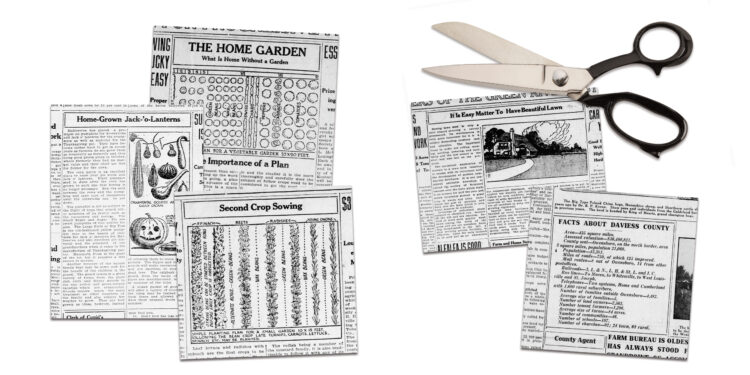One hundred spring seasons have blossomed in Owensboro over the past century, bringing with them too numerous changes to count. But one thing has remained constant since 1924, and that is the eagerness of many local residents to play in the dirt.
An article published in the April 20, 1924, issue of the Owensboro Messenger, credited only to “The Man With Hoe,” extols the many benefits and virtues of raising vegetables for one’s own family.
The article begins with a dire reminder that “Our great grandmothers would have considered the feeding of spinach or beet greens to a year-old baby nothing short of murderous,” but thank goodness for “modern scientific research,” which had proven the rewards of introducing young children to the nutritional benefits of produce grown right at home.
After all, the author insisted, “Green peas and sweet corn cannot be purchased with their sweetness unimpaired. String beans never are quite so tender and well flavored as when gathered in the home garden a few moments before they go in the stew pan. Radishes are never so crisp and snappy as when fresh pulled.”
For those who may have fretted about the extra time and labor involved in tending a home garden, the writer offered this cheery reassurance: “The care of a garden is a small part of the day’s routine once it is started. The wielding of a hoe is as valuable exercise as swinging a golf club and there is something to show for it besides a score card and argument.”
Helpful articles and illustrations published in other editions of the 1924 newspaper demonstrated the importance of planning one’s garden space prior to planting.
“If for no other reason than saving time and speeding up the work of getting a garden going, a plan should be made in advance of the planting season,” readers were told. “This is a much neglected phase of gardening. Haphazard planting, putting seed into the ground on the nearest plot that seems handiest often leads to garden failures.”
The wise gardener should also consider the value of “companion crops,” the writer went on, which involved “making two vegetables come pretty close to occupying the same space.” Examples given included “planting radishes and parsley or carrots in the same row” or “slipping early tomato plans among the beans or in the onion row to keep on going when the other crops are removed.”
A sample sketch of a home garden measuring 10 by 20 feet allowed for the inclusion of parsley, peas, green beans, wax beans, Swiss chard, peppers, cabbage, tomatoes and cucumbers.
Gardeners who were blessed with an abundance of harvest were encouraged to advertise their bounty in the newspaper, as “town and city folk” were known to “drive out into the rural districts and make their purchases of vegetables, dairy products, fruit, etc., thereby getting ‘pedigreed produce’ firsthand and fresh.”
Even city folk, however, were inclined to show off their horticultural talents through the display of a beautiful lawn. That, too, required intentional planning and work, although the headline of one article assured readers that “It Is Easy Matter To Have Beautiful Lawn.”
How easy? Well, “The important items in order are rolling, mowing, weeding, watering, and fertilizing.”
Care was advised in regard to that last item, however: “It is not considered advisable nowadays to spread the coating of farmyard manure over the lawn.” Instead, “Dressings of pulverized sheep manure or shredded cow manure fill the bill and are odorless, devoid of weed seed, quickly wash down among the roots of the grass and are not unsightly.”
White clover was recommended for filling in bare spots, but the homeowner was reminded, “Don’t try to do any renovating in the seed line on a windy day. The seed usually flies everywhere except the right spot.”
The winds of change have continued to blow in Owensboro/Daviess County for 100 years – and longer – but the feeling of pride in a well-maintained lawn (with or without manure) and a bountiful home garden continues to bloom. OL










